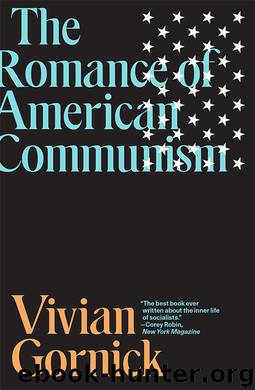The Romance of American Communism by Vivian Gornick

Author:Vivian Gornick
Language: eng
Format: epub, mobi
Publisher: Verso Books
What Mason Goode shares with Esther Allen is the secret conviction that the loss of his creative talent is the price he paid for the festering conflict within which he lived out much of his life as a Communist. What he also shares with her is a deep-seated memory of the profound distaste he felt in his educated middle-class soul for the intellectual and emotional crudities of life in the Party.
When Mason Goode left Alexander Micklejohn’s school in 1931, two large stirrings were at work in him: one had to do with the magical pull that painting exerted on him, the other with the yearning Jeremy Lewiton’s Communism had set going in him. At the time, Mason did not worry about the polar opposites of these twin stirrings. Certainly he did not view them as potential sources of serious inner conflict. On the contrary, he saw them as enriching each other, multiplying experience, enlarging his relation to himself and to the world. He received a scholarship to an art institute in Pittsburgh and went off to study painting with the full conviction that he was a socialist and somewhere, somehow, in the world that lay before him the two parts of himself—the “private” and the “political”—would stream together fruitfully.
In 1933 Mason’s father was dead of acute alcoholism, the family fortune was revealed to be nonexistent, the Depression was at full tilt, and Mason was soon lost to his art studies. He remembers he wandered the streets of Pittsburgh for days, nights, weeks feeling as grey-and-black inside himself as the city around him. He remembers Pittsburgh as a city of bridges under each one of which homeless men camped and slept. “The man under the bridge” became his lifelong image of the Depression.
He returned to New York and began to look for work: in the theater, in graphics, in advertising. None to be found. There was, in fact, a great deal of art and theater going on; aside from Broadway, there was the WPA Theater, the Group Theater, dozens of little loft theaters on Fourteenth Street—all of them alive with “social consciousness,” European modernism, Depression realism, and sometimes outright Marxism. This was true in painting, design, and decoration as well. Radicalism and the arts seemed indeed to have merged, and Mason was in a continual state of responsive excitement, the two parts of the mingled dynamic seeming one to be as good as another. What, after all, did it matter if you worked in the arts or you worked in radical politics? It was all one, all feeding the same source, the same electric sense of life, the same live flow of politics, society, and art streaming together in an intensity of the world that was coming.
When Mason couldn’t get work in the arts he joined the Communist Party. In the Party he experienced immediate satisfaction. Having been denied work in the arts, he felt that here, in the Party, what he actually was, was being used, fully taken up and taken in.
Download
The Romance of American Communism by Vivian Gornick.mobi
This site does not store any files on its server. We only index and link to content provided by other sites. Please contact the content providers to delete copyright contents if any and email us, we'll remove relevant links or contents immediately.
| Anarchism | Communism & Socialism |
| Conservatism & Liberalism | Democracy |
| Fascism | Libertarianism |
| Nationalism | Radicalism |
| Utopian |
The Secret History by Donna Tartt(18844)
The Social Justice Warrior Handbook by Lisa De Pasquale(12141)
Thirteen Reasons Why by Jay Asher(8793)
This Is How You Lose Her by Junot Diaz(6794)
Weapons of Math Destruction by Cathy O'Neil(6142)
Zero to One by Peter Thiel(5685)
Beartown by Fredrik Backman(5596)
The Myth of the Strong Leader by Archie Brown(5425)
The Fire Next Time by James Baldwin(5248)
How Democracies Die by Steven Levitsky & Daniel Ziblatt(5127)
Promise Me, Dad by Joe Biden(5087)
Stone's Rules by Roger Stone(5026)
A Higher Loyalty: Truth, Lies, and Leadership by James Comey(4843)
100 Deadly Skills by Clint Emerson(4840)
Rise and Kill First by Ronen Bergman(4702)
Secrecy World by Jake Bernstein(4644)
The David Icke Guide to the Global Conspiracy (and how to end it) by David Icke(4625)
The Farm by Tom Rob Smith(4435)
The Doomsday Machine by Daniel Ellsberg(4416)
